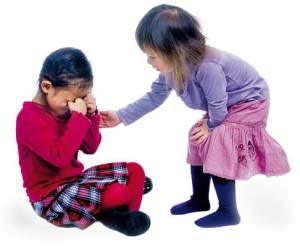If your child is being bullied, you need to intervene on their behalf to get bullying to stop. Here are 5 concrete things you can do to help them overcome the experience.
- Define bullying properly.
- Find out what exactly happened or is happening
- Develop a strategy to get the bully to stop
- Document what is happening thoroughly
- Tend to your child’s psychological needs.
This post includes detailed information on what exactly each of these items entails – sign up for a free membership to read more. You will receive access to a variety of tools including the short course: How to talk to your child’s school about bullying.
1) Define bullying and use the appropriate term – bullying is a general catch all term for a wide variety of behavior. It can be exclusion, name calling, threats of violence, slamming a kid into a locker, stealing from them and a whole lot of other behaviors. It is important to not use the term bullying but actually use the correct terms for the actually behavior so that everyone, including your child, knows what exactly happened and just how serious it is.
2) What exactly happened will determine your response. If your child is being teased, teach them how to respond to get the teasing to stop. If they are being threatened with violence, teach them what to say and who to report it to. Don’t assume they know they should do this.Teach it to them. If it is a credible threat – make sure you follow up and report it as well. If they are being battered, report immediately, follow up and make sure that the offender is referred for disciplinary action and that they will be monitored to make sure they don’t harm your child or anyone else.
3) If the bullying is chronic you will need to take more action and be prepared for this to take some time. The longer a bully has bullied, the harder it is for them to stop because it is a habit they are addicted to. When they are caught and called out or their victim stops responding to them they will enter into what is known as an extinction burst and will essentially escalate their behavior in an attempt to a) get their victim to give up and b) to make everyone else want give up as well. It is vital that the pressure remain on the bully so that they cycle through the extinction burst quickly and learn that they can’t get away with it anymore. To help your child understand this and how important it is that they don’t give up, the more the bully escalates the more obvious it will be to everyone else that this child needs intervention and help to stop what they are doing so they are not only doing this for themselves to get the bully to stop, they are doing this for their classmates and the bullies other victims and for the bully as well. Everyone is going to benefit from your child having the courage to do what it takes to get a bully to stop.
4) Documentation. If the bullying is violent or excessive it may be more than just bullying and actually constitute criminal behavior. By documentating thoroughly what is happening, when it happens and who witnessed it, you provide the school with the resources they need to actually follow up correctly. It also provides a record should law enforcement need to get involved.
5) Make sure your child has access to a counselor or therapist. Your school should have one. Bullying is traumatic and it can cause ptsd. Depending on what is happening, your child may need extra support, make sure they get it.

